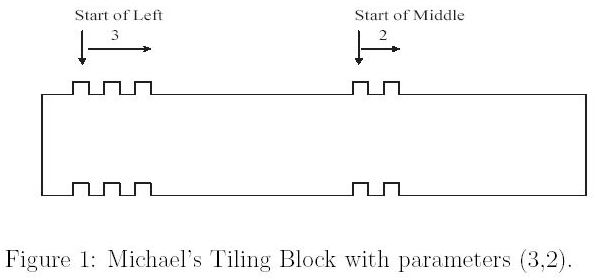POJ1609 UVALive2815 UVA1196 ZOJ1787 Tiling Up Blocks【二维最长上升子序列+DP】
来源:互联网 发布:淘宝正义哥之家店铺 编辑:程序博客网 时间:2024/06/05 15:27
Tiling Up Blocks
Time Limit: 1000MS Memory Limit: 10000KTotal Submissions: 5882 Accepted: 2293
Description
Michael The Kid receives an interesting game set from his grandparent as his birthday gift. Inside the game set box, there are n tiling blocks and each block has a form as follows:

Each tiling block is associated with two parameters (l,m), meaning that the upper face of the block is packed with l protruding knobs on the left and m protruding knobs on the middle. Correspondingly, the bottom face of an (l,m)-block is carved with l caving dens on the left and m dens on the middle.
It is easily seen that an (l,m)-block can be tiled upon another (l,m)-block. However,this is not the only way for us to tile up the blocks. Actually, an (l,m)-block can be tiled upon another (l',m')-block if and only if l >= l' and m >= m'.
Now the puzzle that Michael wants to solve is to decide what is the tallest tiling blocks he can make out of the given n blocks within his game box. In other words, you are given a collection of n blocks B = {b1, b2, . . . , bn} and each block bi is associated with two parameters (li,mi). The objective of the problem is to decide the number of tallest tiling blocks made from B.

Each tiling block is associated with two parameters (l,m), meaning that the upper face of the block is packed with l protruding knobs on the left and m protruding knobs on the middle. Correspondingly, the bottom face of an (l,m)-block is carved with l caving dens on the left and m dens on the middle.
It is easily seen that an (l,m)-block can be tiled upon another (l,m)-block. However,this is not the only way for us to tile up the blocks. Actually, an (l,m)-block can be tiled upon another (l',m')-block if and only if l >= l' and m >= m'.
Now the puzzle that Michael wants to solve is to decide what is the tallest tiling blocks he can make out of the given n blocks within his game box. In other words, you are given a collection of n blocks B = {b1, b2, . . . , bn} and each block bi is associated with two parameters (li,mi). The objective of the problem is to decide the number of tallest tiling blocks made from B.
Input
Several sets of tiling blocks. The inputs are just a list of integers.For each set of tiling blocks, the first integer n represents the number of blocks within the game box. Following n, there will be n lines specifying parameters of blocks in B; each line contains exactly two integers, representing left and middle parameters of the i-th block, namely, li and mi. In other words, a game box is just a collection of n blocks B = {b1, b2, . . . , bn} and each block bi is associated with two parameters (li,mi).
Note that n can be as large as 10000 and li and mi are in the range from 1 to 100.
An integer n = 0 (zero) signifies the end of input.
Note that n can be as large as 10000 and li and mi are in the range from 1 to 100.
An integer n = 0 (zero) signifies the end of input.
Output
For each set of tiling blocks B, output the number of the tallest tiling blocks can be made out of B. Output a single star '*' to signify the end of
outputs.
outputs.
Sample Input
33 21 12 354 22 43 31 15 50
Sample Output
23*
Source
Asia Kaohsiung 2003
Regionals 2003 >> Asia - Kaohsiung
问题链接:POJ1609 UVALive2815 UVA1196 ZOJ1787 Tiling Up Blocks。
题意简述:
若干个积木,每个积木上面有凸起,下面有凹进去的部分。左边凸起与凹进去的个数是一样的,记为L;中间凸起与凹进去的个数也是一样的,记为M。
对应的两个金木能堆起来,当且仅当L1>=L2并且M1>=M2,问最多能堆多高?
问题分析:这是一个二维DP问题。递推式为:dp[i][j] = max(dp[i-1][j],dp[i][j-1])+cnt[i][j]。
程序说明:(略)
AC的C++语言程序如下:
/* POJ1609 UVALive2815 UVA1196 ZOJ1787 Tiling Up Blocks */#include <iostream>#include <stdio.h>#include <string.h>using namespace std;const int N = 100;int cnt[N+1][N+1], dp[N+1][N+1];int main(){ int n, left, mid; while(scanf("%d", &n) != EOF && n) { memset(cnt, 0, sizeof(cnt)); memset(dp, 0, sizeof(dp)); for(int i=0; i<n; i++) { scanf("%d%d", &left, &mid); cnt[left][mid]++; } // DP计算过程 for(int i=1; i<=N; i++) for(int j=1; j<=N; j++) dp[i][j] = max(dp[i - 1][j], dp[i][j - 1]) +cnt[i][j]; printf("%d\n", dp[N][N]); } printf("*\n"); return 0;}阅读全文
0 0
- POJ1609 UVALive2815 UVA1196 ZOJ1787 Tiling Up Blocks【二维最长上升子序列+DP】
- NUC1776 Tiling Up Blocks【二维最长上升子序列+DP】
- POJ1609:Tiling Up Blocks(DP)
- poj1609 Tiling Up Blocks
- POJ1609 Tiling Up Blocks
- poj1609 Tiling Up Blocks
- poj1609 - Tiling Up Blocks(动归)
- poj1609——Tiling Up Blocks
- poj1609 Tiling Up Blocks(LIS)
- 最长上升子序列LIS集合 POJ2533,POJ1631,POJ1887,POJ1609
- hdu 1160 dp (二维最长上升子序列 记录路径
- 最长上升子序列 dp
- DP--最长上升子序列
- PKU2533 最长上升子序列 DP
- PKU1631 最长上升子序列 DP
- 最长上升子序列 (dp)
- 最长公共上升子序列 (dp)
- realoj 134 DP 最长上升子序列
- POJ1830开关问题-高斯消元
- 欢迎使用CSDN-markdown编辑器
- keepalived实现Tomcat服务双机热备
- UIScrollView滚动视图的基本用法
- PHP动态编译出现错误的解决方法
- POJ1609 UVALive2815 UVA1196 ZOJ1787 Tiling Up Blocks【二维最长上升子序列+DP】
- LINUX下的crond和crontab的调研
- maven进阶:一个多模块项目
- 【Pyhton网络爬虫】网络请求使用的urllib模块
- JSP学习笔记(一)------JSP九大内置对象
- SQL新手养成日记
- 网络---TCP协议中的urg和psh的区别
- Socket TCP 协议实现服务端和客户端的简单通信
- 计算机图形学概论


